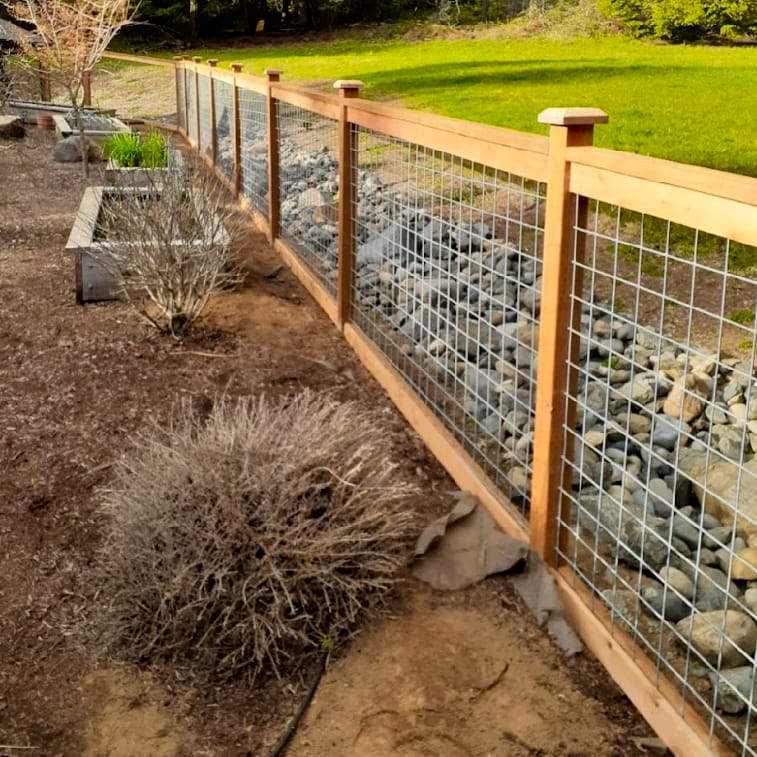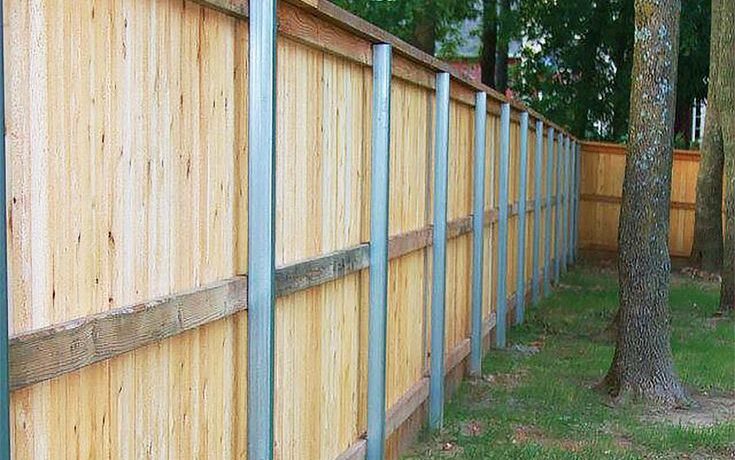All Categories
Featured
When picking a fencing for your residential property, it's important to consider variables like cost, toughness, upkeep, and visual allure. Three of one of the most popular materials for domestic and industrial fences are vinyl, wood, and light weight aluminum. Each offers unique advantages and some drawbacks, making it essential to assess your requirements before making a decision. Listed below, we compare the benefits and drawbacks of these materials to assist guide your choice.
Wood Fencing. Pros:
![]()
All-natural Aesthetic: Wood fencings are recognized for their timeless, all-natural appearance. They can easily mix right into a lot of landscapes and boost the appeal of your home or service. Whether you're intending for a rustic look or an extra sleek coating, wood can be tailored with paint, tarnish, or sealer. Personalization: Wood is one of the most flexible materials, allowing for a wide array of styles, such as picket fences, personal privacy fences, and ranch-style units. It's easy to adjust the layout to fit the certain demands of your home. Budget friendly: Normally, timber fences come with a reduced first cost compared to plastic or aluminum, making them an economical option for those on a budget plan. Cons:
Upkeep Demands: Timber fences require regular upkeep to keep their elegance and capability. This includes staining or painting to shield versus rot, termites, and weather damages. Without appropriate treatment, timber can weaken gradually. Shorter Life-span: Compared to vinyl or light weight aluminum, wood fences tend to have a shorter life-span, particularly in areas with extreme weather condition. Harsh conditions, such as heavy rainfall, moisture, or snow, can create timber to weaken more swiftly. Prone to Damage: Wood fences are at risk to damage from pests, including termites, in addition to all-natural wear from weather condition. They may also warp or split if not correctly maintained. Vinyl Fencing. Pros:
Low Maintenance: Among the major advantages of vinyl fencings is that they require very little maintenance. Unlike timber, plastic doesn't require to be painted, secured, or stained. It's immune to fading, staining, and breaking, which saves time and money on upkeep. Durability: Plastic is known for its capability to stand up to severe climate problems without wearing away. It's resistant to insects like termites, and its resistance to wetness and UV rays guarantees it stays looking great for years. Durable: A plastic fence can last up to thirty years or even more, making it a fantastic long-lasting investment. Many manufacturers offer service warranties, better enhancing its worth. Selection of Styles: Plastic fencings are offered in various colors and styles, including those that imitate wood. You can pick from privacy, picket, or ornamental styles, supplying versatility to match your home or business. Disadvantages:
![]()
Greater Upfront Expense: Vinyl fencings have a tendency to have a greater first expense than timber. While the long-term cost savings on maintenance are significant, the ahead of time investment might be a deterrent for some homeowners. Minimal Customization: Vinyl fencings come in basic layouts, and while colors and designs are different, you might not have as much adaptability for personalization contrasted to wood. Splitting in Cold Climates: While plastic is long lasting, in incredibly cool environments, it can end up being weak and fracture upon effect, which might be troublesome in areas with harsh winter seasons. Aluminum Secure fencing. Pros:
Low Maintenance: Aluminum fencings are understood for their low-maintenance needs. Unlike wood, aluminum doesn't corrosion or rust, and it does not need to be painted or sealed. This makes it a wonderful option for those who want a hassle-free option. Sturdiness and Toughness: Light weight aluminum is a robust product that stands up well to severe weather. It's an outstanding choice for coastal areas where saltwater rust is a problem, as it's resistant to corrosion. Visual Appeal: Aluminum fences supply a tidy, elegant look, usually used for ornamental functions. They're offered in various styles, consisting of decorative designs, and can add a premium feeling to your residential or commercial property. Protection: Aluminum fencings are long lasting and deal fantastic security, particularly when mounted with gateways or locks. Their durable building gives a trusted barrier against undesirable entry. Cons:
![]()
Greater First Price: Light weight aluminum fences have a tendency to be a lot more pricey than wood, particularly if you decide for decorative styles. The upfront cost may be excessive for some. Much Less Personal privacy: Aluminum fences generally have broader spaces in between the slats, which indicates they supply less personal privacy than timber or plastic fences. Light weight aluminum might not be the best option if seclusion is a top priority. Nicking Issues: While light weight aluminum is rust-resistant, it is at risk to flexing or denting if struck with pressure. A vehicle crash or hefty effect can trigger long-term damage to the fence. Which Fencing Product is Right for You? Choosing the best fence depends on numerous factors, including your spending plan, design preferences, upkeep capacity, and the setting in which you live. If you desire an all-natural appearance and are prepared for normal maintenance, wood could be the right option. Vinyl is an excellent option if low-maintenance and durability are your concerns. For those that like a streamlined, contemporary appearance with very little treatment, light weight aluminum offers a long-lasting, secure solution.
Ultimately, each fence product has its cons and pros, so it's important to review what matters most for your certain needs. Think about the climate, the degree of privacy you need, and just how much maintenance you're willing to dedicate to, and you'll find the perfect fence for your building.
Wood Fencing. Pros:

All-natural Aesthetic: Wood fencings are recognized for their timeless, all-natural appearance. They can easily mix right into a lot of landscapes and boost the appeal of your home or service. Whether you're intending for a rustic look or an extra sleek coating, wood can be tailored with paint, tarnish, or sealer. Personalization: Wood is one of the most flexible materials, allowing for a wide array of styles, such as picket fences, personal privacy fences, and ranch-style units. It's easy to adjust the layout to fit the certain demands of your home. Budget friendly: Normally, timber fences come with a reduced first cost compared to plastic or aluminum, making them an economical option for those on a budget plan. Cons:
Upkeep Demands: Timber fences require regular upkeep to keep their elegance and capability. This includes staining or painting to shield versus rot, termites, and weather damages. Without appropriate treatment, timber can weaken gradually. Shorter Life-span: Compared to vinyl or light weight aluminum, wood fences tend to have a shorter life-span, particularly in areas with extreme weather condition. Harsh conditions, such as heavy rainfall, moisture, or snow, can create timber to weaken more swiftly. Prone to Damage: Wood fences are at risk to damage from pests, including termites, in addition to all-natural wear from weather condition. They may also warp or split if not correctly maintained. Vinyl Fencing. Pros:
Low Maintenance: Among the major advantages of vinyl fencings is that they require very little maintenance. Unlike timber, plastic doesn't require to be painted, secured, or stained. It's immune to fading, staining, and breaking, which saves time and money on upkeep. Durability: Plastic is known for its capability to stand up to severe climate problems without wearing away. It's resistant to insects like termites, and its resistance to wetness and UV rays guarantees it stays looking great for years. Durable: A plastic fence can last up to thirty years or even more, making it a fantastic long-lasting investment. Many manufacturers offer service warranties, better enhancing its worth. Selection of Styles: Plastic fencings are offered in various colors and styles, including those that imitate wood. You can pick from privacy, picket, or ornamental styles, supplying versatility to match your home or business. Disadvantages:

Greater Upfront Expense: Vinyl fencings have a tendency to have a greater first expense than timber. While the long-term cost savings on maintenance are significant, the ahead of time investment might be a deterrent for some homeowners. Minimal Customization: Vinyl fencings come in basic layouts, and while colors and designs are different, you might not have as much adaptability for personalization contrasted to wood. Splitting in Cold Climates: While plastic is long lasting, in incredibly cool environments, it can end up being weak and fracture upon effect, which might be troublesome in areas with harsh winter seasons. Aluminum Secure fencing. Pros:
Low Maintenance: Aluminum fencings are understood for their low-maintenance needs. Unlike wood, aluminum doesn't corrosion or rust, and it does not need to be painted or sealed. This makes it a wonderful option for those who want a hassle-free option. Sturdiness and Toughness: Light weight aluminum is a robust product that stands up well to severe weather. It's an outstanding choice for coastal areas where saltwater rust is a problem, as it's resistant to corrosion. Visual Appeal: Aluminum fences supply a tidy, elegant look, usually used for ornamental functions. They're offered in various styles, consisting of decorative designs, and can add a premium feeling to your residential or commercial property. Protection: Aluminum fencings are long lasting and deal fantastic security, particularly when mounted with gateways or locks. Their durable building gives a trusted barrier against undesirable entry. Cons:

Greater First Price: Light weight aluminum fences have a tendency to be a lot more pricey than wood, particularly if you decide for decorative styles. The upfront cost may be excessive for some. Much Less Personal privacy: Aluminum fences generally have broader spaces in between the slats, which indicates they supply less personal privacy than timber or plastic fences. Light weight aluminum might not be the best option if seclusion is a top priority. Nicking Issues: While light weight aluminum is rust-resistant, it is at risk to flexing or denting if struck with pressure. A vehicle crash or hefty effect can trigger long-term damage to the fence. Which Fencing Product is Right for You? Choosing the best fence depends on numerous factors, including your spending plan, design preferences, upkeep capacity, and the setting in which you live. If you desire an all-natural appearance and are prepared for normal maintenance, wood could be the right option. Vinyl is an excellent option if low-maintenance and durability are your concerns. For those that like a streamlined, contemporary appearance with very little treatment, light weight aluminum offers a long-lasting, secure solution.
Ultimately, each fence product has its cons and pros, so it's important to review what matters most for your certain needs. Think about the climate, the degree of privacy you need, and just how much maintenance you're willing to dedicate to, and you'll find the perfect fence for your building.
Latest Posts
Reasons Routine Car Maintenance at Montclare Auto Repair Keeps Your Wallet Happy
Published May 27, 25
1 min read
Find Out Save Big on Car Maintenance with Montclare Auto Repair’s Limited-Time Deals
Published May 25, 25
1 min read
Uncover Save Big on Car Maintenance with Montclare Auto Repair’s Limited-Time Deals
Published May 24, 25
1 min read
More
Latest Posts
Reasons Routine Car Maintenance at Montclare Auto Repair Keeps Your Wallet Happy
Published May 27, 25
1 min read
Find Out Save Big on Car Maintenance with Montclare Auto Repair’s Limited-Time Deals
Published May 25, 25
1 min read
Uncover Save Big on Car Maintenance with Montclare Auto Repair’s Limited-Time Deals
Published May 24, 25
1 min read